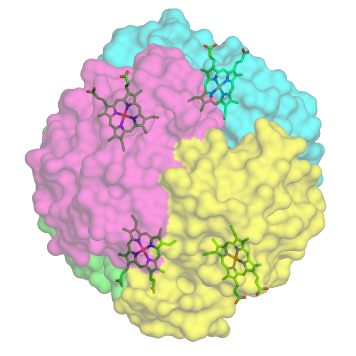For example if the side chain is H, than the amino acid is glycine, if the side chain is CH3, the amino acid is alanine
When two amino acids meet they join
forming a peptide bond. This process
is an example of a condensation
reaction.
When two amino acids join together the molecule is called a di-peptide. When three amino acids join together the molecule is called a tri-peptide. When a chain of amino acids join together, the molecule is called a Polypeptide.
As discussed before proteins form in phases. By this I mean a Primary, secondary, tertiary and quaternary structure.
Primary Structure:
The primary structure is the initial stage of
a protein. This is simple a linear strand of
amino acids, joined together.
Tertiary Structure:
The tertiary structure is a three dimensional
shape. Again depending on the sequence of
amino acids, the tertiary shape will differ. As
you can see from the diagram the tertiary
structure is simply the secondary structure
further coiled, forming a 3D shape. Remember
a proteins structure is related to its function
(enzymes).
During tertiary folding, The R groups attract each other. There are a number of bonds created between the R groups:
- Hydrogen bonds
- ionic bonds
- Covalent bonds
These bonds create the tertiary structure.
Quaternary Structure
The picture to the left is the quaternary structure of a proteins.
The Quaternary Structure refers to two or more polypeptides joining together. A common example is haemoglobin (red blood cells). These are composed of 4 polypeptides.
The basic building blocks of proteins are an Amino acid. There are 20 different types of amino acids, each with a amino group (NH2), a carboxyl group (COOH) and a side chain (R).
The specific side chain or R group, determines the amino acid. Just like a base on a nucleotide.
Secondary Structure:
Hydrogen bonding between the CO and NH groups of the amino acids causes the shape of the protein to go from linear, to
Beta-pleating or Alpha-helix.
Depending on the sequence of amino acids in the primary structure, the exact shape of the Secondary structure will change.
Helping Proteins Fold
A single amino acid out of place can cause improper folding of a protein, and there for ruin the structure of the protein. To make sure this doesn’t happen, there are specific enzymes which recognise improperly folded proteins and destroy them.
As we know proteins can come in all shapes and sizes. Smaller polypeptide chains can fold spontaneously into their secondary and tertiary shape. However large poly-peptides require the help of chaperone proteins. These molecules are produced in huge quantities within the cell and are specialised proteins which ensure the polypeptide folds into its correct shape.
When cells are exposed to heat, proteins denature and the hydrogen bonds between amino acids break, this causes the protein to lose its shape. Chaperone proteins, assist in reforming these proteins and ensure they fold correctly. This is why they have been given the name Heat shock proteins.
So what do Proteins do?
Proteins are a vital part of cellular activity. Within the cell they have many different roles:
- Enzymes control cellular processes
- Fibres provide Structural support and movement
- Membrane bound they provide
o Passages of transport for large molecules
o Recognition
- They help in Signal transduction and hormones
- They assist in cellular recognition, self from non-self.
These are only a few of the ways, proteins assist us in life.
Denaturing Proteins
When a protein denatures, its quaternary, tertiary and secondary structure is broken. This is because the bonds that hold these structures in place are broken. Hydrogen and ionic bonds are weak, and therefore easily broken by Heat or pH. However covalent bonds, such as peptide bonds, are strong. This is why the primary structure is unaffected by extreme heat or pH.
Proteomes and Proteomic
The proteome is all the proteins encoded by the genome. Proteomics refers to the study of the structure, function and interactions of proteins.
Surprisingly we share a great deal of our proteome with other organisms. 61% of our proteome is similar to that of a fruit fly and 46% to baker’s yeast. This information suggest, that we all evolved from a common ancestor.
Click here for questions on proteins










